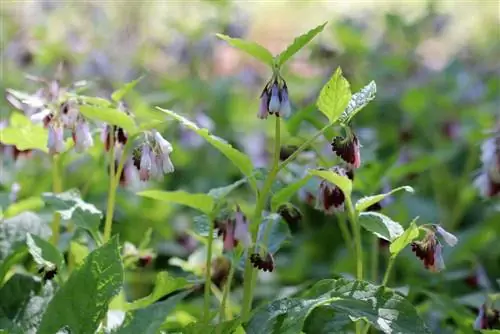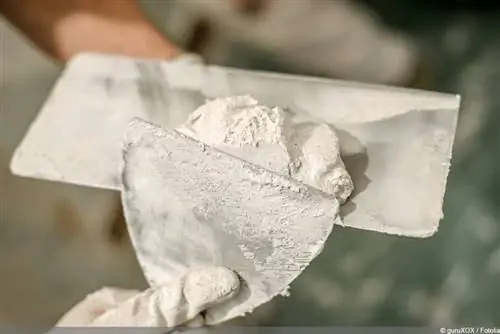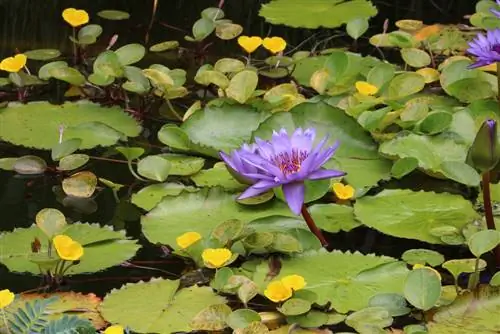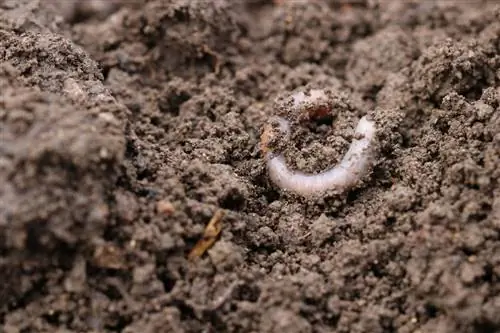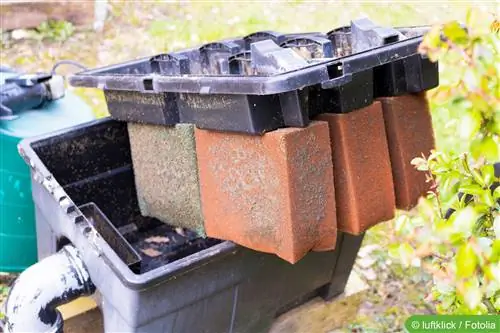- Author admin [email protected].
- Public 2023-12-17 03:39.
- Last modified 2025-06-01 06:48.
The orchid is probably one of the best-known and most popular flowers that can be found in German homes and gardens. There are over 1,000 genera worldwide and of these, the Epidendroideae, which occur mainly in the tropics, represent the largest family of Orchidaceae. Due to the five primary subfamilies and the three growth forms, different substrates are required for cultivation and location in the bed or pot. Of course, there are a variety of substrates available commercially, but you can mix the appropriate substrate yourself and use it for your orchids without much difficulty. All you need to do is know which substances are suitable as a substrate for the orchids and in what proportion they are mixed.
Why is a substrate needed?
Due to the many species of orchids, there is no uniform substrate that is suitable for growing all Orchidaceae. For example, tropical species require an airy substrate that dries quickly so that the roots do not rot and die. Many European or Arctic orchids, on the other hand, tolerate well-drained soil like that found in conventional gardens. When keeping orchids, it is important to imitate the original location of the species and this is done through the substrate. Since the roots, especially in tropical species, are not underground, they are exposed to a lot of fresh air and only absorb as much water from the rain as they need. Each species determines its growth habit and it is therefore important to adapt precisely to the needs of the plant. The following growth forms can be found in orchids:
- on plants (epiphytic)
- on stones or rocks (lithophytic)
- on or in the earth (terrestrial)
Tip:
If you find out about the type of orchid before choosing the substrate, you will save a lot of time and money. This means you can choose the right substrate in the right size right from the start and enjoy he althy orchids.
Components of the substrates

The combination of organic and inorganic ingredients for the substrates can often be found in commercial products. However, substrates made purely from inorganic substances, sometimes even chemically produced, are also offered, which are only in very few cases beneficial for the growth of orchids. A gentle alternative to the inorganic variants are substrates that consist exclusively or mainly of organic substances and are enriched with inorganic substances. These range from classic bark to charcoal and clay. Each substrate has its advantages and disadvantages and should therefore be precisely coordinated so that water absorption and delivery to the plants works effectively. The following components are used for the substrates.
Bark
The bark of various trees has been used for decades to grow and keep orchids. This is mainly because the majority of orchids on the market are tropical and subtropical species that grow on trees, so it makes sense that bark is very suitable for the plants. The bark is available in different grain sizes and is best known as a standard substrate for orchids of the genus Phalaenopsis, the moth orchids. Pine is usually used for the bark and it comes in grain sizes from less than ten millimeters to over 30 millimeters. The principle applies here: the finer the root of the orchid, the finer the grain of the bark substrate should be. Further advantages of bark substrates are:
- decomposes very slowly
- releases lots of nutrients to the orchid
- increased water permeability
- suitable for epiphytic orchids
Natural fibers
Natural fibers include the following components:
- Wood
- Beech leaves
- Coconut
- Cork
- Nutshells
- White peat
- Moose
These substances are all suitable as additions to the substrate for epiphytic species and support the absorption, distribution and storage of moisture. All of these components except the white peat decompose over time and release nutrients to the plant. Coconut fibers ensure good ventilation, especially in young specimens, as do nut shells, which are a nutrient-rich alternative to wood and coconut. The individual components can be mixed very easily and tailored to the individual orchid species, which makes them so effective to use. A maximum of 30 percent of white peat should be added to the substrate, otherwise it will suffocate the roots. White peat lowers the pH value of the substrate and is very structurally stable, just like beech leaves, cork and wood.
Sphagnum
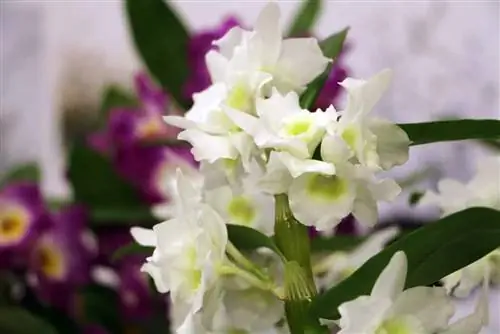
Sphagnum moss is a unique moss that can be used for species that are particularly demanding, have very fine roots and require a lot of water. Since this moss is protected, it is one of the most expensive substrates and is beneficial for the genera Phragmipedium, Disa or Dracula.
Minerals
The minerals in the substrate include sand and lime, which support the orchids with their properties. Sand is a way to dry the substrate of terrestrial orchids if it has become too wet. Lime, on the other hand, is used as an important trace element and ensures effective water absorption. Nevertheless, hard water should never be used for orchids. Tip: You can also get lime from eggshells, mussels or other calcareous shells, stones or foods. It doesn't always have to be a commercial additive.
Soil and compost
Classic garden soil is recommended for a small number of terrestrial orchids. For example, Bletilla species benefit from nutrient-rich soil. When selecting the soil, you should pay attention to good quality with high permeability, because here too, too much waterlogging should not develop. Humus, compost and coniferous humus are also recommended for the substrates. They enable higher nutrient absorption for species such as Pleione and the needle humus in particular shines as a component of the substrate. It is acidic and does not burden the orchid with s alts. However, humus and compost can become infested with pests, so greater care must be taken when using these substances.
Volcanic rock
Pure volcanic rock is used as a substrate for the smallest group of orchids, the lithophytes. These species grow on rocks and therefore require the volcanic rock to select the necessary nutrients. Other stones can also be chosen for this, but coarse volcanic rock is more suitable. A well-known substrate made from volcanic rock is perlite, which ensures effective drainage of epiphytic species by foaming the stone. However, due to processing, perlite is an inorganic substance that is suitable for young plants with sensitive roots.
Charcoal
Charcoal is an effective substance to combat bacteria in the substrate. It should be used in almost all substrates because it disinfects, loosens and acts against toxic substances. It maintains the vitality of the orchid, but is somewhat less aesthetic than other additions due to its dark color.
Inorganic substrates
The inorganic substrates include a large group of substances that should be used carefully. Styrofoam, foam or foamed plastic are only suitable to a limited extent, as they often store too much water or do not release any water to the plant. Expanded clay, lavalite (for lithophytes), clay (for terrestrial orchids), seramis, rock wool (odontoglossum) and zeolite (effective against ammonium), on the other hand, are specialized for certain needs when keeping orchids and are therefore suitable. They have almost no negative properties, except that the expanded clay can sometimes become a little s alty. Before adding them to the substrate, you should consider the species for which they are worthwhile. They ensure good drainage and help absorb water without depriving the orchid of air.
Advantages of self-mixed substrates

Substrates for Orchidaceae from the market are a dime a dozen and many of these recipes are only partially suitable for the plants. A typical mistake of these substrates is the excessive use of peat, which, however, can strangle the plant and cause the roots to rot. Pest infestation can also occur, as the finished substrate is often the perfect breeding ground for insects. An example are fungus gnats, which like to attack plants and can cause significant damage to them. For this reason, we recommend a substrate from your own “production”, which is gentler and more effective for the flowers in terms of the proportions.
Make your own substrate - instructions
- Once you have decided on the components of your substrate, the substrate can be mixed. All you need are the components and the flower pot or the marked out area of the garden or garden house if you are planting terrestrial orchids.
- Consider the pot or location you chose for the orchid. The dimensions and volume determine how much of the substrate is required. The following applies here: for small pots and young plants, a finer substrate should be chosen so that the roots can develop better. In addition, a finer grain fits better in flower pots with less volume and makes it easier to change to a larger flower pot if the orchid needs one during growth.
- Bark should be disinfected before adding to the substrate. To do this, you can either hold the bark over steam for 30 minutes, put it in the microwave for a few minutes, or put it in the oven for several hours. This process helps to remove microorganisms and bacteria that could negatively affect the growth of the orchids.
- Depending on the type of orchid, a different mixing ratio should be chosen. However, for the majority of epiphytic species, pine bark is chosen as the main ingredient and refined with other ingredients. Epiphytes benefit from mixtures that are about 50 to 70 percent, or five to seven parts, bark. The other parts can theoretically be chosen freely. There are individual recipes for each type of orchid that you can try out.
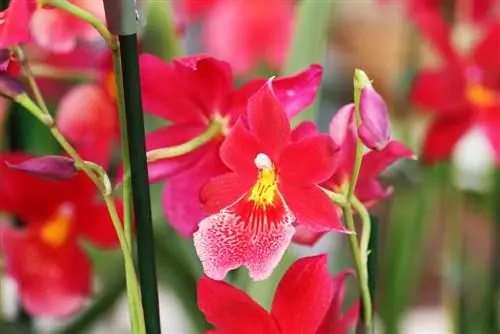
- First add the bark to the flower pot, depending on the amount the flower pot can hold. Then add the individual parts of the other ingredients and mix the substrate well by hand. Tip: Remove the individual components from the bags by hand. This means that no dust gets into the substrate, which is caused by transport and storage, especially with bark and wood fibers, and you can also check the majority of the pieces for rotten spots or pest infestation.
- Charcoal is either added directly to the substrate as a base in the flower pot.
- Lime is added to the substrate as needed.
- Now the orchid is placed in the substrate, as well as fertilizing and watering if necessary.
Terrestrial orchids and lithophytic species
The substrate for terrestrial orchids consists largely of soil, humus or compost, which is enriched with other components such as seramis. As with other flowers, the orchid is simply placed in the ground. A unique form of substrate is found in lithophytic species. A whole chunk of volcanic rock is often used here, onto which the orchid with its open roots is attached using strings. It can root itself in the stone and is supplied with its nutrients. This form of substrate is becoming increasingly popular because it is a unique eye-catcher and corresponds to the plant's natural habitat.


